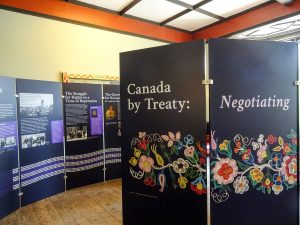
PHOTO BY CLARRIE FEINSTEIN/GLEANER NEWS: A Hart House Map Room exhibition that runs until May 26 aims to educate Canadians on the role of treaties in Canadian history. Canada By Treaty: Negotiating Histories — curated by history professors Heidi Bohaker and Laurie Bertram, and senior undergraduate student James Bird — is a direct response to one of the calls to action put forward by the Truth and Reconciliation Commission of Canada in 2015.
As Canada celebrates 150 years of colonialist history, this display presents another vital component to our history, which has forever shaped the relationship between Indigenous and non-Indigenous people. The exhibit delves into the geographic land negotiations — treaties — that predate Canadian Confederation. Each of the 24 panels provides a comprehensive explanation of the complicated history of treaties, with panels providing information on residential schools and treaties, wampum belts and treaty records, the role of Indigenous women in treaty-making, and the University of Toronto’s own complicated affiliations with land negotiations.
The exhibit contextualizes the nuances of these agreements, tracing the shift from alliance treaties initially between various First Nations and later with the European settlers in Canada, which brought on the period of land surrender, and ends with the recent treaties of the Nunavut Land Claims Agreement and the Nisga’a Final Agreement — the latter of which was approximately 100 years in the making. The land claims process is still going on: much of British Columbia, Quebec, and Newfoundland and Labrador are the subject of claims that have not yet been settled.
The display strongly emphasizes the important distinction that needs to be clarified: treaties were shaped by negotiation not conquest. The repercussion of treaties has resulted in the displacement and exploitation of Indigenous peoples because colonialists did not follow through on promises made in these land negotiations. The exhibit highlights a history that must come to the forefront in our national consciousness — an accessible room in Hart House teaching this history for all Torontonians is a start, but more needs to be done.
—Clarrie Feinstein/Gleaner News
READ MORE
NEWS: Reclaiming the Anishinaabe past (April 2017)
LIFE: Indigenous Games coming in July (March 2017)
NEWS: Building a stronger relationship (February 2017)
FOCUS ON EDUCATION: Decolonizing our schools (December 2016)
FOCUS ON EDUCATION: Building a respectful future (November 2016)
HISTORY: Honouring those who honour history (October 2016)
NEWS: U of T committee tasked with responding to Truth and Reconciliation Commission delivers interim report (August 2016)
ON THE COVER: Tracking history in the Annex (April 2016)
